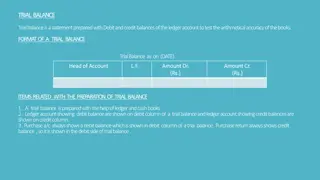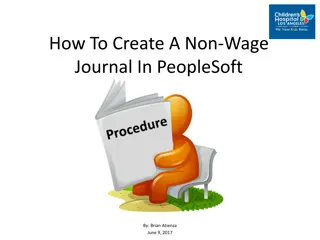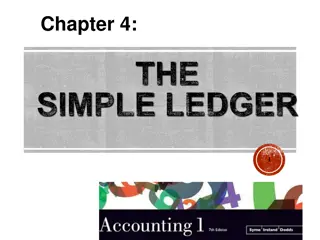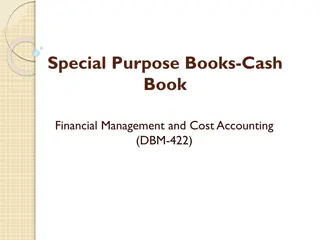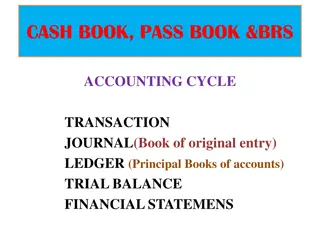Understanding Journal and Ledger in Financial Management
Explore the significance of the Journal and Ledger in financial management. Learn how transactions are recorded in chronological order, and understand the characteristics and steps involved in journalizing. Discover the different types of accounts like Personal and Real accounts that are essential for proper financial record-keeping.
Download Presentation

Please find below an Image/Link to download the presentation.
The content on the website is provided AS IS for your information and personal use only. It may not be sold, licensed, or shared on other websites without obtaining consent from the author. Download presentation by click this link. If you encounter any issues during the download, it is possible that the publisher has removed the file from their server.
E N D
Presentation Transcript
Journal and Ledger Financial Management (DBM-422) A K JHA
Introduction The business transactions are recorded in the books of accounts viz.Journal and Ledger. Ledgers is also called principal books of accounts. - All accounting information can be secured from the Ledger. Posting of entries in Ledger is made from the Journal, which is known as Subsidiary Book of accounts. Entries are made chronologically on the basis of the source documents. A voucher indicating accounts to be debited or credited is prepared and recorded systematically in the Journal
Journal A journal is the primary book of accounts in which transactions are originally recorded in the chronological manner. - It is the book of original entry. Records are thereafter transferred to ledger. A journal is chronological record of financial transactions of a business (M.J.Keeler). An entry made in journal is termed as a Journal Entry and the process is called journalising. The transfer of Journal entry is called Posting.
Characteristics of a Journal 1. It contains transactions in a chronological order. 2. It is the book of original entry in which transactions are analysed before posting in the Ledger. 3. Using double entry system of Book keeping, it records both the debit and credit aspects of a transaction. 4. It is a record that depicts the complete detail of a transaction in one entry.
Steps in Journalising 1. Determine what accounts are affected by a transaction. 2. Ascertain what is the nature of the account affected. 3. Applying the rules of debit and credit, ascertain which account is to be debited and which account is to be credited. 4. Ascertain the amount by which the accounts are to be debited and credited. 5. Write date,month and year in the Date column. 6. In the Particulars column,record the name of the account to be debited with abbreviation Dr. in the same line. The amount to be debited is recorded in the DebitAmount Column .
Steps in Journalising 7. Again record the name of the account to be credited in the particulars column in the next line preceded by the word To in the right. Amount to be credited should be written in the CreditAmount column. 8. A brief description of narration) is written underneath in the next line in the Particulars column. 9. Draw a line across Particulars column to separate one Journal entry from the other. the transaction (called
Types of Accounts There are three types of accounts 1.Personal Accounts The accounts of all those persons organizations / entities from whom the company has either to receive money or has to pay money, are called personal accounts. 2.Real Accounts The firm also owns property like land, building, plant and machinery, stock, cash etc. The accounts of various assets or property acquired by the firm, are classified as Real account. 3.Nominal Accounts The accounts of various items which represent either income and gain or expenses and loss of the firm are nominal accounts. For example accounts of rent, wages, salary, telephone bills are classified as nominal accounts. Similarly dividend received a/c. interest earned a/c, commission a/c are also nominal accounts.
Rules of Debit and Credit Types of Account Debit Credit 1. Personal Account The Receiver The Giver 2. Real Account What comes in What goes out 3. Nominal Account Expenses and Losses Incomes and Gains
Journal columns can be understood by observing the following hypothetical entry: Date particulars L.F. Dr. (Rs.) 3,000 Cr. (Rs) 2020 May 01 Cash A/c To Ramesh (being cash received from Ramesh in payment of the amount due from him) .... Dr. 60* 24* 3,000 * 60 refers to the page in the ledger where cash account is recorded and 24 shows the page where Ramesh s account has been maintained.
Recording in Journal Transactions are recorded in Journal on the basis of source documents in accordance with the rules of debit and credit. Example 1: Ramesh started business and invested Rs 5,oo,ooo on 1st May 2019 in cash as capital. The transaction will be recorded in the Journal as: Date particulars 2019 may 01 (being the amount invested in business) L.F. Dr. (Rs.) Cr. (Rs) 51 15 Cash A/c To Ramesh s capita A/c .... Dr. 5,00,000 5,00,000 Reason: (i) Cash Account is debited because it is received by the firm. It being a real account, is debited as per the rule debit what comesin and credit what goes out. Ramesh s capital account is credited because the firm has assumed a liability toward him. It being a personal account, the rule Debit the receiver and Credit the giver is applied.
Example 2: Purchased a machine from Sonu & Sons for Rs. 50,000 on 01.05.2019 and made a cash payment. The transaction will be journalised as : Date 2019 may 01 particulars Machine A/c To Cash A/c (being machine purchased against cash) L.F. 48 51 Dr. (Rs.) Cr. (Rs) 50,000 .... Dr. 50,000 Reason: (i) Machine Account is debited because the firm has purchased i.e. Received it. It being a real account, is debited as per the rule debit what comesin . (ii) Cash account is credited because the firm has paid cash for the purchase of machine. It being a real account , the rule Debit what comes in and credit what goes out is applied.
Example 3: Purchased goods for Rs 60,000 for cash on June 15, 2019. The transaction will be recorded by passing the following Journal entry: Date Particulars L.F. Dr. (Rs.) Cr. (Rs.) 2019 June 15 Purchase A/c To Cash A/c (Being the goods purchased for cash) ...Dr. 30 51 60,000 6,0000 Reason: (i) Purchase account is debited because the firm has purchased goods for the sale. It being a nominal account, is debited as per the rule debit all expenses and losses and credit all incomes and gains. (ii) Cash account is credited because the firm has paid cash for the purchase of goods. It being a real account , the rule Debit what goes out is applied.
Example 4: Paid rent Rs 5000 in cash on June 01, 2019. The transaction will be recorded by passing the following Journal entry: Date Particulars L.F. Dr. (Rs.) 5000 Cr. (Rs.) 2019 June 01 Rent A/c To Cash A/c (Being the rent paid in cash) ...Dr 27 51 5000 Reason: (i) Rent account is debited because it is an expense. It being a nominal account, is debited as per the rule debit all expenses and losses and credit all incomes and gains. (ii) Cash account is credited because the firm has paid cash towards this expense. It being a real account , the rule Debit what goes out is applied.
Example 5: Paid a creditor Rs 5000 on June 01, 2019. The transaction will be recorded by passing the following Journal entry: Date Particulars L.F. Dr. (Rs.) 5000 Cr. (Rs.) 2019 June 01 Creditor A/c To Cash A/c (Being the amount paid to creditor) ...Dr 28 51 5000 Reason: (i) Creditor account is debited because the firm has paid liability towards a creditor. It being a personal account, is debited as per the rule debit the receiver and Credit the giver (ii) Cash account is credited because the firm has paid cash. It being a real account , the rule Debit what goes out is applied.
Example 6: Interest received Rs 2500 in cash on June 01, 2019. The transaction will be recorded by passing the following Journal entry: Date Particulars L.F. Dr. (Rs.) 2,500 Cr. (Rs.) 2019 June 01 Cash A/c To Interest Received A/c (Being the amount paid to creditor) ...Dr 51 32 2,500 Reason: (i) Cash account is debited because the firm has received cash. It being a real account, is debited as per the rule debit what comes in and credit what goes out. (ii) Interest paid account is credited because the firm has received income. It being a nominal account, the rule Debit all expenses and credit all income is applied.
Opening Entry At the end of a financial year business firms close their book of accounts. The first entry in Journal depicts the closing balances of individual assets and liabilities of the previous year. The same balances become the opening balance of the new financial year which is called an Opening Entry. The balance sheet prepared at the end of the year shows the closing balance of each asset and liability. While passing an opening entry all assets are debited and liabilities are credited.
Example of Passing and Opening Entry Balance Sheet As at March 31, 2019 Liabilities Mohan & sons Capital Rs. 18,000 70,000 Assets Cash in Hand Cash at Bank Debtors Closing Stock Machinery and Equipment Rs. 2,500 35,500 5,000 20,000 25,000 88,000 88,000 Based on the above Balance Sheet, the opening entry will be: Particulars Cash A/c Bank A/c Sundry Debtors Stock A/c Machinery and Equipment A/c To Mohan & Sons To Capital A/c (Being the balance brought forward) J.F. Dr. (Rs.) 2,500 35,500 5,000 20,000 25,000 Cr. (Rs.) ...Dr. ...Dr. ...Dr. ...Dr. ...Dr. 18,000 70,000
Advantages of Journal Journal minimises the possibility of Error Amount to be debited and credited are written side by side and both can be compared. They should be equal. Journal gives explanation of the transactions. Due to complete explanation in the entry it is easy to understand the entry later. Journal provides the chronological record of all transactions. The order in which they occur, enters the record permanently.
Ledger In an account transactions of one nature are posted. All the accounts put together constitute a Ledger. A Ledger is book which contains a permanent record of all transactions in a summarised and classified way. It is the book which is used to prepare a trial balance and from the trial balance financial statements are prepared. Ledger is also called the PrincipalBook of accounts.
Utility of Ledger A Ledger is the Principal Book of account that contains all details about business transactions. Essential for preparation of final accounts as it provides necessary information about various accounts. Personal account in the Ledger shows how much amount of money the firm owes to its creditors and the amount it has to recover from the debtors. The real accounts depict the value of properties and the value of stock. Nominal accounts depict the source of income and also the amount spent on various items. The process of transferring the information from the Journal to the Ledger is Called Posting .
Steps in posting of Account debited in a Journal entry Identify in the Ledger the account to be debited Enter the date of transaction in the date column on the debit side Write the name of the account that has been credited in the respective entry in the particulars column on the debit side of the account as To followed by the name of account to be credited. Record the page number of the Journal where the entry exists in the J.F. Column. Enter the relevant amount in the Amount column on the debit side. 1. 2. 3. 4. 5.
Steps in posting of Account credited in a Journal entry Identify in the Ledger the account to be credited. Enter the date of transaction in the date column on the credit side Write the name of the account that has been debited in the respective entry in the particulars column on the credit side of the account as By followed by the name of account to be debited. Record the page number of the Journal where the entry exists in the J.F. Column. Enter the relevant amount in the Amount column on the credit side. 1. 2. 3. 4. 5.
Balancing a Ledger Balance of an account is the difference between debit and credit totals of an account. Accounts are balanced every year or after certain intervals after transactions. It is done to ascertain the net effect of entries in the accounts. Balancing an account implies that both the sides of an account has been totalled and the difference in the total of the two sides is written on the side whose total is short. For instance, if the total of the debit side is more than credit side of an account, the difference amount is recorded as Balancec/d on the credit side. posting of all
Balancing a Ledger If the total of the debit side of an account is greater, that account indicates a debit balance. If the total of the credit side of an account is greater, that account indicates a credit balance. The debit balance is then written on the debit side as To balance brought down or To balance b/d, which becomes the opening balance for the new period. The credit balance is then written on the credit side as By Balance b/d. This becomes the opening balance for the new. Where the total of debit and credit side are equal, balancing is not required. Note: only real and personal accounts are to be balanced. Nominal accounts are generally not balanced rather at the end of the accounting period; their totals are transferred to Profit and Loss Account.
Process of Balancing Ledger Accounts Find out the difference Find out the difference Make he total of Debit Side equal to Credit Side Make he total of Debit Side equal to Credit Side Draw a double line after the total Bring forward the balance on the next page Draw a double line after the total Bring forward the balance on the next page







